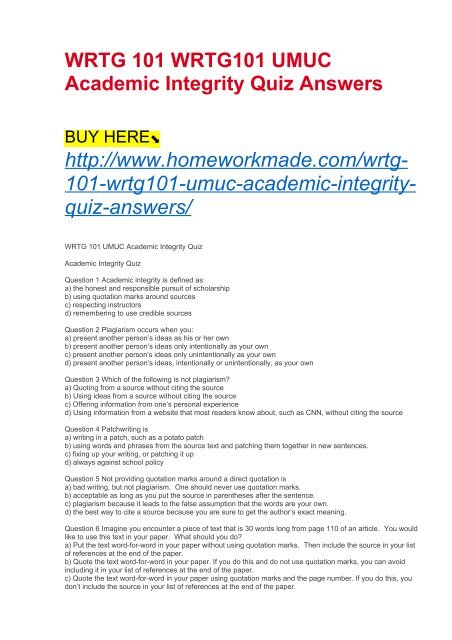WRTG 101 WRTG101 UMUC Academic Integrity Quiz Answers
Create successful ePaper yourself
Turn your PDF publications into a flip-book with our unique Google optimized e-Paper software.
<strong>WRTG</strong> <strong>101</strong> <strong>WRTG</strong><strong>101</strong> <strong>UMUC</strong><br />
<strong>Academic</strong> <strong>Integrity</strong> <strong>Quiz</strong> <strong>Answers</strong><br />
BUY HERE⬊<br />
http://www.homeworkmade.com/wrtg-<br />
<strong>101</strong>-wrtg<strong>101</strong>-umuc-academic-integrityquiz-answers/<br />
<strong>WRTG</strong> <strong>101</strong> <strong>UMUC</strong> <strong>Academic</strong> <strong>Integrity</strong> <strong>Quiz</strong><br />
<strong>Academic</strong> <strong>Integrity</strong> <strong>Quiz</strong><br />
Question 1 <strong>Academic</strong> integrity is defined as:<br />
a) the honest and responsible pursuit of scholarship<br />
b) using quotation marks around sources<br />
c) respecting instructors<br />
d) remembering to use credible sources<br />
Question 2 Plagiarism occurs when you:<br />
a) present another person’s ideas as his or her own<br />
b) present another person’s ideas only intentionally as your own<br />
c) present another person’s ideas only unintentionally as your own<br />
d) present another person’s ideas, intentionally or unintentionally, as your own<br />
Question 3 Which of the following is not plagiarism?<br />
a) Quoting from a source without citing the source<br />
b) Using ideas from a source without citing the source<br />
c) Offering information from one’s personal experience<br />
d) Using information from a website that most readers know about, such as CNN, without citing the source<br />
Question 4 Patchwriting is<br />
a) writing in a patch, such as a potato patch<br />
b) using words and phrases from the source text and patching them together in new sentences.<br />
c) fixing up your writing, or patching it up<br />
d) always against school policy<br />
Question 5 Not providing quotation marks around a direct quotation is<br />
a) bad writing, but not plagiarism. One should never use quotation marks.<br />
b) acceptable as long as you put the source in parentheses after the sentence.<br />
c) plagiarism because it leads to the false assumption that the words are your own.<br />
d) the best way to cite a source because you are sure to get the author’s exact meaning.<br />
Question 6 Imagine you encounter a piece of text that is 30 words long from page 110 of an article. You would<br />
like to use this text in your paper. What should you do?<br />
a) Put the text word-for-word in your paper without using quotation marks. Then include the source in your list<br />
of references at the end of the paper.<br />
b) Quote the text word-for-word in your paper. If you do this and do not use quotation marks, you can avoid<br />
including it in your list of references at the end of the paper.<br />
c) Quote the text word-for-word in your paper using quotation marks and the page number. If you do this, you<br />
don’t include the source in your list of references at the end of the paper.
d) Put the text word-for-word in your paper, but make sure to put quotations around the text and cite the<br />
source. Note that it came from page 110. Then include the source in your list of references at the end of the<br />
paper.<br />
Question 7 A rubric<br />
a) is an argument that is supported by research and strong evidence<br />
b) describes the criteria that must be met for an assignment to be successful<br />
c) begins with the ability to identify when additional information is needed<br />
d) is a game in cube form that children and adults play<br />
Question 8 A database is<br />
a) a collection of logically stored information<br />
b) anything stored in the cloud<br />
c) a collection of baseball facts<br />
d) a mathematical principle<br />
Question 9 A trade journal<br />
a) is good for exchanging with other people<br />
b) provides specialized news on an industry<br />
c) is the same as a popular journal<br />
d) is the best journal to turn to when you are changing your topic because you are “trading” topics<br />
Question 10 A popular journal is<br />
a) one that has high public opinion<br />
b) written for a specialized audience<br />
c) written for a general audience<br />
d) the best source for a paper because it is popular among the audience of readers<br />
Question 11 When paraphrasing a passage for your paper, you should<br />
a) use most of the words from a passage<br />
b) keep the sentence structure of the article from which you are using the idea<br />
c) use the author’s phrasing, as this practice will ensure that you maintain the author’s idea.<br />
d) use your own phrasing<br />
Question 12 When quoting a passage for your paper, you should<br />
a) use quotation marks (“…”)<br />
b) not use quotation marks. Using quotation marks distracts the reader.<br />
c) always use block quotations. This practice will set apart the quote for the reader of your paper.<br />
d) use single quotation marks (e.g., ‘…’). Double quotation marks are not used in academic writing.<br />
Question 13 What is the best strategy for integrating source material into a research paper?<br />
a) Use only direct quotes from the sources. This strategy ensures that you are presenting source material<br />
accurately.<br />
b) Summarize any information. Avoid directly quoting sources or paraphrasing sources.<br />
c) Mix paraphrases with summaries. Avoid quoting sources directly.<br />
d) Balance the use of summaries, paraphrases and quotes so that the sources integrate with your style and<br />
argument.<br />
Question 14 Quotes, summaries, and paraphrases should be used<br />
a) to support a student’s thinking and writing.<br />
b) instead of a student’s thinking and writing.<br />
c) only when the student has no opinion on the topic.<br />
d) all of the above<br />
Question 15 What is not an example of a signal phrase?<br />
a) Smith (2014) argues….<br />
b) According to Elm and Barry (2009)...<br />
c) “The mark of an educated person is the ability to learn from others” (Cini, 2015).<br />
d) In his seminal study in 2011, Jones illustrates….

















